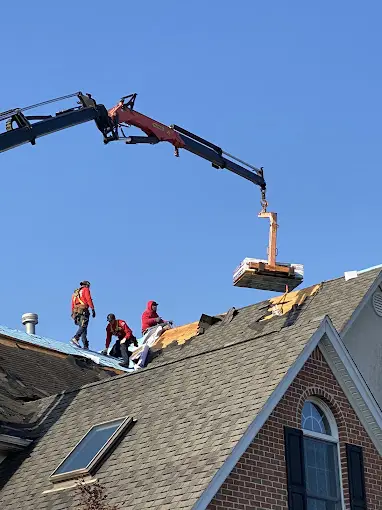A Complete Homeowner's Guide to Fire-Resistant Shingles for Long Island Homes
Over 35 Years as a Roofer in Long Island
While many homeowners have smoke alarms and fire extinguishers, they often forget about the importance of a fire-resistant roof. Installing fire-resistant asphalt shingles can significantly improve your home’s resilience to fire. This guide will explain how asphalt shingles are rated for fire resistance, why they matter for your home, and how to choose the best fire-resistant options for your Long Island residence.
What Are Fire-Resistant Asphalt Shingles?

Fire-resistant asphalt shingles are specially designed roofing materials that resist ignition and slow the spread of fire. These shingles provide essential protection for homes in areas where wildfires, electrical malfunctions, or accidental fires pose a risk. Asphalt shingles with fire-resistant properties meet strict safety standards, offering a durable and cost-effective solution for safeguarding your home.
You don’t have to sacrifice style for safety. Fire-resistant shingles come in a wide range of colors and styles, allowing you to match the look of your roof with your home’s architectural style. Whether you prefer traditional three-tab shingles, architectural shingles, or designer shingles, you can find fire-resistant options that don’t compromise on appearance.
Not all asphalt shingles are created equal, and it’s important to choose shingles from a reputable manufacturer known for producing high-quality, fire-resistant roofing materials. Look for shingles with comprehensive warranties, including protection against fire damage, to ensure long-term peace of mind.
Proper installation is critical when it comes to protecting your home from fire. Even the best Class A shingles will underperform if not installed correctly. Make sure to hire a licensed, experienced roofing contractor who understands the nuances of installing fire-resistant roofing materials and adhering to local building codes.
How Are Fire-Resistant Asphalt Shingles Made?
Standard asphalt shingles are typically composed of a fiberglass mat, covered with asphalt and mineral granules. To make them fire-resistant, manufacturers enhance the materials in several ways:
Fiberglass Core: Asphalt shingles with a fiberglass mat provide a higher level of fire resistance compared to those with organic bases. The fiberglass layer is non-combustible, helping prevent the spread of flames.
Fire-Resistant Coatings: Fire-resistant asphalt shingles are often treated with additional fire retardant chemicals. These additives enhance the shingle’s ability to withstand heat and exposure to direct flame.
Mineral Granules: The top layer of asphalt shingles is coated with mineral granules, which act as a protective barrier against UV rays, impact, and fire. These granules contribute to the shingle’s fire resistance by preventing flames from penetrating the surface.
How Are Asphalt Shingles Rated for Fire Resistance?
Roofing materials, including asphalt shingles, are rated for fire resistance according to their ability to withstand fire exposure. Independent organizations like Underwriters Laboratories (UL) and ASTM International perform rigorous testing. They then place shingles into one of three fire-resistance categories: Class A, Class B, or Class C.
The laboratories use these tests to determine shingle fire resistance:
- Burning Brand Test: Testers place a burning wooden brand on the shingle surface to assess how well it resists ignition.
- Spread of Flame Test: The test evaluates how fast flames spread across the roof’s surface when exposed to fire.
- Intermittent Flame Test: Shingles are exposed to a flame that cycles on and off, simulating real-world fire conditions, to test the material’s ability to resist catching fire over time.
Class A Fire-Resistant Asphalt Shingles
Class A is the highest fire-resistance rating for roofing materials, offering the best protection against fire. They can withstand severe fire exposure, which makes them ideal for areas prone to wildfires or homes near wooded regions with elevated fire risks.
Key Characteristics of Class A Fire-Rated Shingles:
- Can withstand direct exposure to fire for up to two hours without igniting.
- Resist the spread of flames and prevent embers from igniting other parts of the roof.
- Provide excellent protection against wind-blown sparks and embers.
Class B Fire-Resistant Asphalt Shingles
Class B fire-rated shingles provide a moderate level of fire protection. These shingles will resist moderate exposure to fire but may not offer the same level of protection as Class A shingles.
Key Characteristics of Class B Fire-Rated Shingles:
- Can resist direct exposure to fire for up to one hour.
- Offer moderate protection against flames and embers.
- Often made from treated materials to improve their fire resistance.
Class C Fire-Resistant Asphalt Shingles
Class C fire-rated shingles provide the lowest level of fire resistance. These shingles can withstand light fire exposure but are more prone to ignition in the event of severe fire. Most Long Island building codes prohibit the use of Class C shingles.
Key Characteristics of Class C Fire-Rated Shingles:
- Can withstand direct flame exposure for up to 20 minutes.
- Offer minimal protection against embers and wind-driven sparks.
- Made from materials that are more combustible than Class A or Class B shingles.
CertainTeed's Class A Fire Resistant Shingles
Protect Your Home with
Class A Fire Resistant Shingles
Even when a fire isn’t directly threatening your home, wind-driven embers can travel long distances and pose a severe risk. These embers can land on your roof, gutters, or nearby landscaping and ignite a fire on your property. Class A fire-resistant asphalt shingles are designed to withstand high temperatures and prevent embers from igniting your roof, offering a vital defense against these hidden dangers.
You don’t generally think of wildfires on Long Island. But various factors—including home proximity to wooded areas, electrical faults, and severe weather—can increase fire risk. Here are several reasons why choosing Class A shingles is crucial for protecting your Long Island home.
Protection Against External Fires
Whether it’s a wildfire, a neighboring house fire, or an electrical fire sparked by downed power lines, Class A shingles act as a strong barrier against flames. They slow the spread of fire, providing valuable time for firefighters to respond and minimizing damage to the rest of your home.
Defense Against Wind-Driven Embers
Even when a fire isn’t directly threatening your home, wind-driven embers can travel long distances and pose a severe risk. These embers can land on your roof, gutters, or nearby landscaping and ignite a fire on your property. Class A fire-resistant asphalt shingles will withstand high temperatures so embers can’t set your roof on fire.
Slowing the Spread of Home Fires
Class A shingles can help slow the spread of the fire across the roof. Since these shingles are less likely to catch fire and burn quickly, they reduce the chances of the fire spreading to other parts of the house. This containment can give you and your family more time to evacuate and for emergency responders to arrive.
Increased Home Value and Insurance Benefits
Installing Class A fire-resistant asphalt shingles can also increase the value of your home. Buyers are increasingly aware of the importance of fire safety, and homes equipped with fire-resistant features are often more attractive to prospective buyers. Additionally, many insurance companies offer discounts for homes with fire-resistant roofing materials, which can lead to long-term savings on homeowner’s insurance.
Maintenance of Class A Fire Resistant Shingles
Once you’ve installed fire-resistant asphalt shingles on your Long Island home, regular maintenance is key to preserving their fire resistance and ensuring optimal performance.
Schedule Regular Inspections
Schedule routine roof inspections, especially after severe weather events like storms or high winds. Inspecting your roof helps identify any potential damage that could compromise the fire resistance of your shingles, such as cracked or missing shingles. Through early detection of issues, you can prevent small problems from escalating into costly repairs.
Keep Gutters and Roof Clear of Debris
Debris such as leaves, twigs, and pine needles can accumulate on your roof and in your gutters, creating potential fire hazards. These materials are highly flammable and can ignite if exposed to wind-driven embers. By regularly cleaning your roof and gutters, you will reduce this risk and help maintain your roof’s fire resistance.
Trim Overhanging Branches
Trees close to your home pose additional fire risks. Overhanging branches can catch fire and spread flames to your roof. Regularly trimming back trees and ensuring that vegetation is properly maintained will minimize this risk and protect your roof from external fire threats.
People Also Ask...
In over 3 decades of contracting work on Long Island, we’ve worked with many local home equity lenders. Give us a call and let us help you find financing.

